A brooding man from Oregon comes closer, his gaze fixed on yours. He places a red-stained hand on your shoulder, and says… “It’s OK, this is only paint. Want to do some writing with me? It’s about Whitechapel and 1888.” To which the answer should be No, because I usually have little time for Jack the Ripper and the occasionally distasteful mythologising around him – or her.
But this man from Oregon is author and award-winning artist Alan M Clark, who did something very different with the Autumn of Terror in his series of intricate novels about the women who were killed, and their often tragic lives. And I had foolishly let one little thing slip concerning Mr Dry, the infamous Deptford Assassin, and those particular events. So I said Yes, instead. Alan is excellent to work with, and the project has proved very interesting.
Here’s Alan himself on the issues, the process and the state of this dark affair so far…
Shadows of Whitechapel
Is the image above a picture of Jack the Ripper’s last victim, Mary Jane Kelly? No, probably not. The woman in the photo is an attractive woman from the late Victorian period. Based on her clothing, makeup, and hair style, I’d say she might have been a prostitute. I placed the picture in this post to give a face to Mary Jane Kelly. Miss Kelly was a 19th century prostitute, a ladybird, she might have said. As far as I know, there are no pictures of her face.
I have been collaborating with author, John Linwood Grant in the past few months on two novels involving Mary Jane Kelly. They are related pieces with linked storylines, but written separately—he’s writing, The Assassin’s Coin, concerning the professional beginnings of his wonderful character, Mr. Dry, the Deptford Assassin, and I’m writing, The Prostitute’s Price, the fifth novel in my Jack the Ripper Victims Series. The links between the two stories are plot elements involving some characters, with the time period, and the environment common to both works. Some scenes occur in both novels, written from the POV of my main character in my story, his main character in his. The goal is to have two novels that, when read together, intertwined as we’re calling it, give the reader a broader understanding and a larger experience of each story. When published, the book will have chapters alternating between his novel and mine. The novels will possibly also both be published independently because each one is designed to be a complete standalone story.
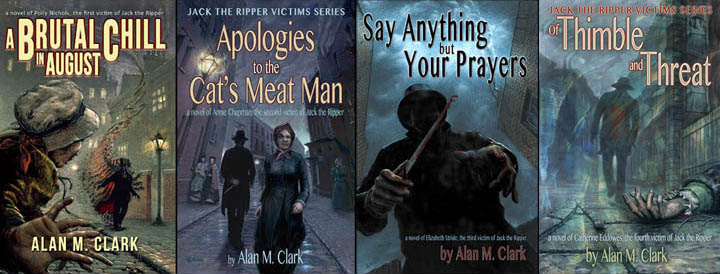
My Jack the Ripper Victims Series is about the lives of the murderer’s victims, depicting what we know about each of the women in dramas that are fiction, but well-researched and meant to give readers a sense of what life might have been like for them in London of the time. There are five canonical victims of the Whitechapel Murderer. Before I started this project with John, I’d written novels about the first four: A Brutal Chill in August, about Mary Ann “Polly” Nichols, Apologies to the Cat’s Meat Man, about Annie Chapman, Say Anything but Your Prayers, about Elizabeth Stride, and Of Thimble and Threat, about Catherine Eddowes. The fifth book in the series is The Prostitute’s Price.
Although I’d intended to write the novel about Mary Jane Kelly, the Ripper’s last victim, I found myself shying away from the effort and then avoiding the work entirely for a time.
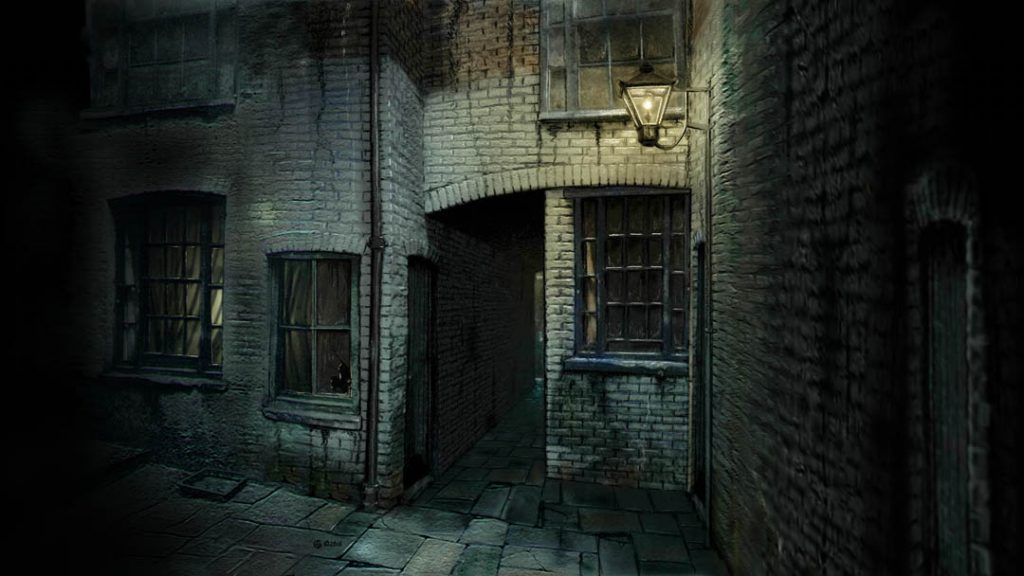
If you’ve seen the crime scene photos, perhaps you’ll understand why. At least two exist, one that is perhaps the primary taking in the whole scene, the other a close up. Much of the “trash” in the photographs exists because the images now available are from photographic products that have deteriorated with age. Those materials would be going on 130 years old. They have what looks like dust and scratches or perhaps water damage that led to mold, mildew, fungus. Whatever the cause, the deterioration has a very dirty look, making what is a disgusting scene, usually seen in a brown sepia-tone, look even worse. Taken in London’s East End in 1888, the images seem to speak accurately of what was a very filthy part of the world in the late Victorian period, indeed a place and time with some of the most impoverished people the world has known. Yet when the photos were first created, they probably had much less trash in them, and would have provided a clearer view of the victim, Mary Jane Kelly.
I considered showing the grimy photos here, but decided that those who haven’t seen them are better off. Unfortunately, these words may pique the curiosity of some who will look for the photographs.
Here is a photograph of the outside of 13 Miller’s Court, to give you an idea of what the photography of the time looked like.
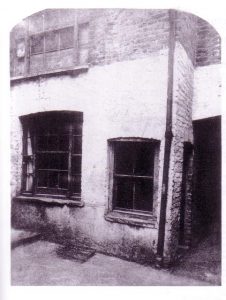
The mutilation of the corpse in the photo is so extreme that it somehow wounds my sense of human worth and dignity. The outrage of the wasted humanity is bad enough, but seeing those pitiful remains on a bed in a small, squalid single-room dwelling, I also suffer an odd claustrophobia, a feeling of being trapped in that tight space at 13 Miller’s Court, where true horror took place. That gives me such a cold, dreadful feeling, I didn’t want to begin the work on the novel about Mary Jane Kelly.
Despite my revulsion, having written novels about the first four victims, I had to complete the project with the fifth.
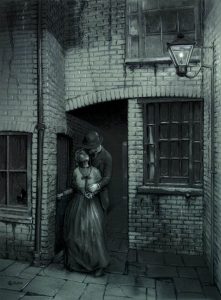
In the midst of considering how best to start, John Linwood Grant asked me to write an introduction for, A Persistence of Geraniums and Other Worrying Tales, a wonderful collection of his short fiction that he calls Tales of the Last Edwardian.
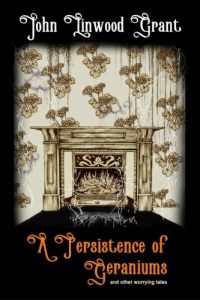
The Edwardian period begins after the end of the Victorian period. We were both writing stories that take place in similar eras, and each of us enjoyed the other’s work. Several of the stories in A Persistence of Geraniums and Other Worrying Tales are about his character, Mr. Dry, the Deptford Assassin. I’d read at least three stories involving the character already, but loved them enough to read them again. In one, John gives a brief backstory for the assassin in which Mr. Dry has dealings with Jack the Ripper during the Autumn of Terror. Brief though it is, knowing quite a bit about the crimes and investigation, I found the backstory quite plausible and that gave me an idea of how to approach my novel about Mary Jane Kelly. I asked John to collaborate, and he accepted the challenge.
Here is a representation by artist Walter Sickert of Miller’s Court from very close to the time of the murder.
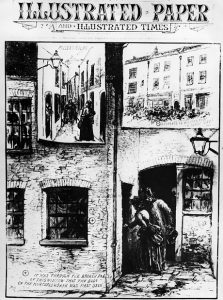
I won’t say more about the backstory of Mr. Dry here, because that is at the heart of the two novels we’re writing and I don’t want to give anything away.
I’ve always loved discovery in creative endeavor. Collaboration, with two or more imaginations coming together, is chocked full of it. This collaboration of intertwined novels is truly a strange one. Our assumptions about it have evolved. At the beginning, we intended to write one novel and work on that together. I presumed we’d both contribute to each chapter. Then we decided, that since we each had our own POV characters to deal with, John would write every other chapter and I’d write the rest. I’d done that with Jeremy Robert Johnson in our collaborative novel, Siren Promised. The approach worked well. Our different writing voices gave our characters distinctly different personalities. Then I proposed to John the idea of writing the separate, but related novels that could be intertwined.
Here’s why: Over the years I’d learned that frequently readers shy away from collaborations because they might know the work of one author of a collaborative novel, but not both. If they like the work of one of the authors, and don’t know the other, they sometimes think that if they buy the book, they’ll get a piece of writing by the author they do know that is watered down by the contribution of the author they don’t know.
With what were doing, one can read the novels together or separately, read one and not the other, and still have a whole experience. Of course I suggest readers enjoy both.
Writing separate novels, we are truly only consulting with one another about how to address the elements common to both works. That has taken some doing, and has been a fun process, involving much consultation via email, chat, and skyping, with an eight hour time difference between us, as John lives in Yorkshire, UK, and I’m in Eugene, Oregon in the United States.
The second image in this post is an expanded view of Miller’s Court, part photo manipulation, part drawing. If you click on it, you can see it larger and in greater detail. It is the core image in the short animated film, I did titled “13 Miller’s Court.” The broken window belongs to the room I spoke of in this post, 13 Miller’s Court, where Mary Jane Kelly was murdered. The image is derived from the black and white image with this post titled ”Miller’s Court,” and photographs of the actual Miller’s Court, also posted here, taken in the 19th century. The drawing is my reimagining of he illustration by the artist, Walter Sickert, that appeared in the Penny Illustrated Paper about a week after the murder. It is colored pencil on gray paper.
Because of my background as a horror illustrator, many who have not read the novels in the Jack the Ripper Victims Series presume they are horror novels. They are not, though they certainly have horrific elements. They are tales of survival within a harsh environment, dramas with strong female leads. They are, in fact, written for women, yet not exclusively so. Men like them too. Each one is from the singular POV of one of the victims. As a male author, it has been a great challenge to write from these feminine POVs, one that I’ve enjoyed immensely, and has helped me to love women all the more.
Thanks to John Linwood Grant for helping me enlarge the series with his own amazing contribution.
The novels The Assassin’s Coin, by John Linwood Grant, and The Prostitute’s Price, the fifth novel in my Jack the Ripper Victims Series will come out later this year in a book tentatively titled 13 Miller’s Court.
—Alan M. Clark
Eugene, Oregon
On the subject of Whitechapel and the Autumn of Terror, whilst I do steer clear of most interpretations I can at least recommend Sam Gafford’s novel Whitechapel (2017). This excellent book takes the whole matter in a somewhat different direction, with a complex interwining of classic author Arthur Machen, the London of the time and cosmic horror. Great read – available in print or Kindle formats on Amazon UK and Amazon US.


